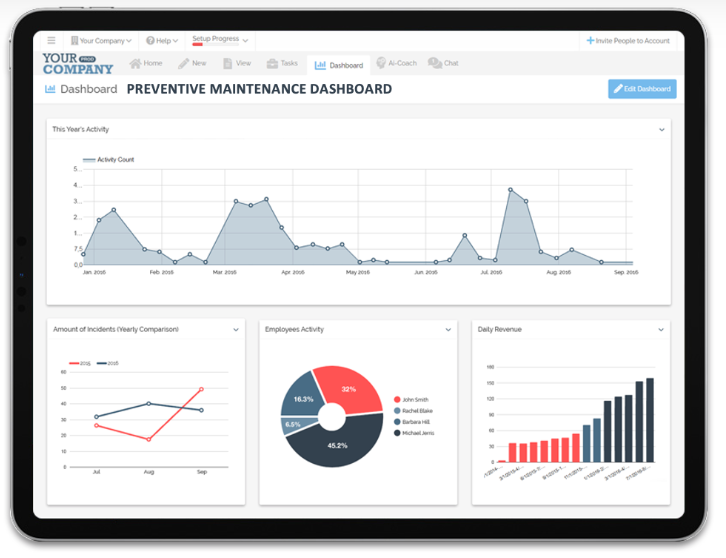Preventive maintenance, often referred to as “proactive maintenance,” is an indispensable facet of maintaining the efficiency and durability of equipment. This practice involves scheduled inspections, routine maintenance tasks, and a commitment to preserving the optimal functionality of equipment.
In this comprehensive article, we will delve deeper into the world of preventive maintenance, exploring the critical aspects, importance, essential elements, benefits, standard techniques, challenges, and effective planning of this approach.
Effective Preventive Maintenance Planning

Effective planning is the key to the success of any preventive maintenance program. It involves the creation of a well-structured maintenance schedule, the assignment of responsibilities to qualified personnel, and meticulous record-keeping.
To streamline and enhance planning, many organizations now utilize specialized software solutions tailored to their unique maintenance needs.
These tools help in efficiently scheduling maintenance tasks, tracking equipment status, and generating reports for analysis.
Importance of Preventive Maintenance
To understand the significance of preventive maintenance, think of it as akin to scheduling regular check-ups with your doctor. Just as these check-ups help detect and address health issues before they become severe, preventive maintenance helps ensure your equipment remains in excellent condition.
The advantages are manifold, ranging from extending the equipment’s operational lifespan to averting unforeseen breakdowns that can disrupt your operations and result in costly repairs.
Tools and Software for Preventive Maintenance – Integrate FAT FINGER

Most companies have tools to assist their preventive maintenance endeavors—these range from simple checklists to spreadsheets, and manual processes.
But these tools lack the sophistication required to streamline the planning and execution of maintenance. Which is why we recommend making a shift to FAT FINGER.
Benefits of Using FAT FINGER
- Customizability
You can tailor workflows in FAT FINGER to suit the complexity of the equipment and the specific requirements of the maintenance program.
- Adaptable to changing trends
As technology continues to advance, the field of preventive maintenance evolves as well. IoT (Internet of Things), predictive analytics, augmented reality are transforming the way organizations approach maintenance.
FAT FINGER puts you in a position to take advantage of these trends, as it integrates these trends in your systems, allowing you to further enhance the effectiveness and efficiency of preventive maintenance programs.
- Streamlined Data Collection
Traditional paper-based data collection methods are often prone to errors and inefficiencies. FAT FINGER offers a user-friendly interface that enables maintenance technicians to input data digitally, reducing the chances of human error. This streamlined data collection process not only saves time but also ensures the accuracy of the recorded information.
- Enhanced Accuracy
Accurate data is crucial for making informed decisions in preventive maintenance. FAT FINGER provides real-time data that is easily accessible and can be analyzed promptly. This accuracy allows maintenance teams to identify potential issues before they become significant problems, reducing downtime and maintenance costs.
- Improved Decision-Making
With the data collected and analyzed through FAT FINGER, maintenance managers and technicians can make data-driven decisions. They can prioritize maintenance tasks based on real-time information, ensuring that critical equipment receives immediate attention while optimizing resource allocation.
Key Elements of Preventive Maintenance
Regular Inspections
Regular inspections serve as the cornerstone of preventive maintenance. These checks encompass visual assessments, the identification of anomalies, and meticulous data recording for trend analysis. The goal is to spot potential problems in their infancy, allowing for proactive intervention before they escalate into equipment failure.
Lubrication
Proper lubrication is a fundamental practice in maintenance. It’s the equivalent of oiling the hinges of a creaky door to ensure it swings smoothly. Lubrication minimizes friction, reduces wear and tear, and guarantees that the equipment operates seamlessly. The choice of lubricants and the frequency of their application are critical considerations in this process.

Equipment Testing
Periodic testing of equipment is essential to unveil hidden issues that might not be apparent through visual inspection alone. Advanced diagnostic tools or software, such as vibration analysis or thermography, can identify irregularities in the equipment’s operation, helping maintenance teams address them proactively.
Common Preventive Maintenance Techniques

Oil Changes
Routine oil changes are one of the simplest yet most effective maintenance techniques just as your car engine needs clean oil for optimal performance, machinery benefits from regular oil changes to avoid equipment damage and maintain proper functionality.
Cleaning and Calibration
Thorough cleaning and calibration are indispensable practices to maintain equipment precision and extend its operational life. Proper cleaning ensures that parts do not become clogged or obstructed, while calibration helps fine-tune the equipment for precise operation.
Replacement of Worn-out Parts
Wear and tear are inevitable in any machinery. However, replacing worn-out components as part of preventive maintenance can prevent further damage and maintain equipment efficiency. This practice is particularly crucial for moving parts or components that experience significant stress.
Preventive Maintenance vs. Reactive Maintenance
It’s worth taking a moment to distinguish preventive maintenance from reactive maintenance. Reactive maintenance, sometimes known as “breakdown maintenance,” involves fixing equipment only when it breaks down.
While this approach may seem cost-effective in the short term, it often leads to higher costs in terms of emergency repairs, downtime, and lost productivity.
In contrast, preventive maintenance is proactive. It aims to prevent breakdowns by addressing potential issues before they cause catastrophic failures, saving both time and money in the long run.

Measuring the Effectiveness of Preventive Maintenance
Measuring the effectiveness of your preventive maintenance program is crucial for continuous improvement. Key performance indicators (KPIs) help assess the success of the program and identify areas for enhancement. These KPIs can include metrics such as equipment uptime, maintenance costs, and mean time between failures (MTBF).
Use FAT FINGER to Implement Preventive Maintenance in Your Organization

Prevent costly breakdowns, ensure the longevity of your equipment, and gain unlimited access to maintenance data with FAT FINGER.
Use the drag-and-drop workflow builder to:
- Create detailed maintenance schedules
- Assign responsibilities to qualified personnel
- Identify training needs for staff members
Features of FAT FINGER
Easy-to-use interface: Workers can promptly and accurately document testing through an easy-to-use interface even in high-pressure industrial environments, ensuring accuracy and efficiency.
Data-Driven Insights: The software generates comprehensive reports and visualizations, empowering organizations to make informed decisions.
Integrated Workflows: FAT FINGER seamlessly integrates maintenance reporting into existing industrial workflows, ensuring a cohesive approach to safety and operational excellence.
Real-Time Collaboration: FAT FINGER facilitates instant communication between your team, supervisors, and management, expediting response times and fostering collaboration.


